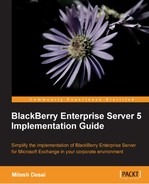Book Description
Simplify the implementation of BlackBerry Enterprise Server in your corporate environment
- Install, configure, and manage a BlackBerry Enterprise Server
- Use Microsoft Internet Explorer along with Active X plugins to control and administer the BES with the help of Blackberry Administration Service
- Troubleshoot, monitor, and offer high availability of the BES in your organization
- Updated to the latest version - BlackBerry Enterprise Server 5 Implementation Guide
In Detail
BlackBerry Enterprise Server (BES) is a platform that extends corporate messaging and collaboration services to BlackBerry devices. It supports management and administration of devices, and also supports deployment of third-party applications on the BlackBerry device platform. The basics of installing BlackBerry Enterprise Server are familiar for most administrators, but the server is infinitely configurable and contains extended administration features.
This book focuses on BlackBerry Enterprise Server for Microsoft Exchange, providing detailed information on planning and implementing a BlackBerry Enterprise Server deployment. It will show you how to use the BES to manage the flow of e-mail data ensuring that it is directed to its ultimate destination – the BlackBerry Smartphone. It covers all the new features of the BES version 5.0 and also looks at areas that have been enhanced from the previous versions. If you are new to BlackBerry Enterprise Server, this is the perfect guide to help with your planning and deployment.
BlackBerry Enterprise Server supports a variety of messaging platforms, including Microsoft Exchange, IBM Lotus Domino, and Novell GroupWise. As you begin reading this book you will first learn about the two prominent features introduced with BES 5: BlackBerry Administration Service Console and Server Routing Protocol. As you proceed further you will learn about 200 more configurable IT Policies provided by BES 5 as opposed to the earlier versions. We will look at Mobile Data Service and third-party applications that can be deployed to BlackBerry devices. We will also look at a monitoring portal included in the installation process of BES 5, which provides health scores to check the BES performance and a much more stable and robust SNMP. Written by mobile and wireless technology experts, this book provides a detailed approach to installing, configuring, and managing your BlackBerry Enterprise Server.
A straightforward guide to setting up your BlackBerry Enterprise Server, provisioning users and devices, and implementing administrative techniques
Table of Contents
- BlackBerry Enterprise Server 5 Implementation Guide
- BlackBerry Enterprise Server 5 Implementation Guide
- Credits
- About the Author
- About the Reviewer
- www.PacktPub.com
- Preface
- 1. Introduction to BES 5
- New features of BES 5.0
- BES version 5.0 architecture
- BES network requirements
- BESAdmin account
- Lab 1 — installing BlackBerry Enterprise Server 5.0
- Creating the service account — besadmin
- Installing BES version 5
- Applying the Maintenance pack
- Summary
- 2. Understanding and Administrating BES 5
- 3. Activating Devices and Users
- 4. IT Policies
- 5. Software Configuration and Java Applications
- Overview of the process
- Software configurations
- Lab 5
- Changing a standard application policy
- Creating a custom application control policy
- Assigning the software configuration to a group
- Deploying device software to BlackBerry devices
- Updating the BlackBerry device software over the wireless network
- Deploying device software using Web Desktop Manager — an example
- Installing the BlackBerry device software
- Creating the shared folder
- Allowing the BlackBerry Administration Service to display the device software configuration settings
- Adding the shared folder to the BlackBerry Administration Service
- Creating the BlackBerry device software configuration
- Creating a software configuration for the BlackBerry device software
- Assigning the software configuration to a user
- Assigning the software configuration to a group
- Summary
- 6. MDS Applications
- 7. High Availability
- 8. Upgrades
